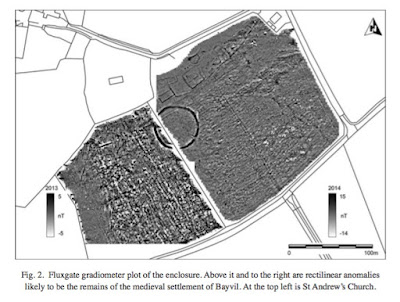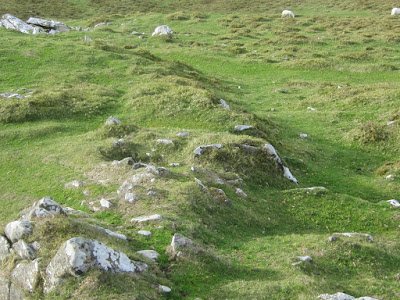Suggested pattern of ice flowlines for the Anglian Glaciation.
We should all take this map seriously. It shows -- in modified form -- the essential features of the reconstruction by Geoffrey Kellaway and his colleagues in 1975 of the ice cover and ice directions in the Celtic Sea arena during the Saalian (Anglian) glaciation. We can assume that this was the Greatest British Glaciation (GBG) -- at least in this arena. Maybe things were different in the North Sea arena.
The reference and abstract for the paper are given below.
Kellaway and his colleagues were concerned about the "English Channel Glacier" -- arguing that ice that came in from the west affected many of the English Channel /Manche coasts. Let's leave that argument to one side for the moment, and concentrate on what happened out in the Celtic Sea. On the above map I have drawn a suggested ice limit between the tip of SW England and the NW tip of Brittany.......... and assumed that the English Channel may have been ice-free. That, of course, is a matter for debate:
https://brian-mountainman.blogspot.com/2018/10/glaciation-of-english-channel.html
This is the original map from the paper by Kellaway et al (1975)
Kellaway and his colleagues appear to have been quite correct in their suggestions that ice (1) reached the shelf edge; (2) completely overrode the Isles of Scilly; (3) impinged upon the coasts of Devon and Cornwall and probably merged with ice from local ice caps; (4) moved both towards W and E from an ice shed situated over SW Ireland; and (5) pushed from the west with sufficient power to force its way into the Bristol Channel as far as Somerset and Wiltshire and maybe to cut off the supply of Irish Sea ice to the south of St George's Channel. Without this massive pressure from the west it is difficult to see how and why an Irish Sea Glacier in the Celtic Sea would have had a sufficient surface gradient for lateral spreading almost 200 km to the east of its central flowline -- always assumed to have been broadly NNE -- SSW in the Anglian glaciations. In the Devensian glaciation it seems clear that the ice did not press so far to the east, but the overall pattern of flow lines might have been similar. The propose ice shed is shown with the broad yellow line on the top map.
Because this glacial episode occurred around 450,000 years ago, it is difficult to find traces of it on land, and equally difficult to find traces in the very dynamic submarine environment.
With mich more work still be be published by the BRITICE project, it will be interesting to see whether there are clear traces of pre-Devensian glacial deposits in the Celtic Sea -- and interesting to see whether these are derived from the Irish Sea Glacier or whether they have come from Ireland and from an ice dome or ridge based on the Celtic Sea platform itself.
It will also be interesting to see whether modelling work confirms that accumulation here near the SW edge of the British and Irish Ice Sheet could have been sufficient to maintain an ice sheet in approximately the position indicated.
In the meantime, let's refer to this as the "Kellaway Hypothesis" and see whether anybody will take it seriously, either for the Anglian or the Devensian.
================
http://rsta.royalsocietypublishing.org/content/roypta/279/1288/189.full.pdf
Phil. Trans. R. Soc. Lond. A. 279, 189-218 (1975)
The Quaternary history of the English Channel
By G. A. Kellaway, J. H. Redding, E. R. Shephard-Thorn and J.-P. Destombes
Abstract
Several lines of evidence for former glaciation of the English Channel are considered. These include the following major geomorphical features: (1) extensive areas of flat featureless sea bed bounded by cliffs with residual steep-sided rock masses rising about 60-150 m above them, (2) terrace forms bounded by breaks in slope or low cliffs, (3) palaeovalley systems related to the present land drainage, (4) enclosed deeps (fosses); all except (3) may be attributed to a glacial origin. The distribution of erratics on the Channel floor and in the modern and raised beaches of its coasts are attributed to widespread Saalian glaciation. This glaciation was responsible for the deposition of morainic material at Selsey and the damming-up of glacial Lake Solent. The so-called ‘100 foot raised beach’ of west Sussex is now re-interpreted as a fluvioglacial deposit laid down at the northern margin of the English Channel ice. It is thought that at the height of the Saalian glaciation mean sea-level fell to between 90 and 180 m below o.d. and that for a time the ice was grounded near the western margin of the continental shelf. Possible reconstructions of the limits and main movements of the Weichselian and Saalian ice sheets covering the British Isles and English Channel are included.











































